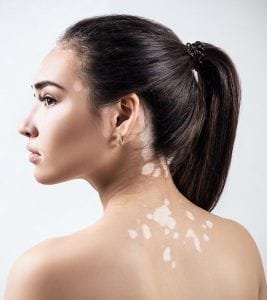
Vitiligo Treatment: Causes, Types, and Best Solutions
What is Vitiligo?
Vitiligo is a skin condition characterized by the loss of melanin, leading to white patches on the skin. It occurs when melanocytes, the pigment-producing cells, are destroyed or stop functioning. While vitiligo is not harmful or contagious, it can impact a person’s confidence and emotional well-being.
At Dr. Kritika Derma Clinic & SkinSalud, we offer advanced and personalized vitiligo treatments to help restore skin pigmentation and improve overall skin health.
Causes of Vitiligo
Although the exact cause of vitiligo is unknown, several factors may contribute:
- Autoimmune Response – The body’s immune system mistakenly attacks melanocytes.
- Genetic Factors – A family history of vitiligo increases the risk.
- Environmental Triggers – Sunburn, skin trauma, or chemical exposure may trigger depigmentation.
- Neurogenic Factors – Nerve-related factors might contribute to melanocyte destruction.
Types of Vitiligo
1. Non-Segmental Vitiligo (Generalized Vitiligo)
- Most common type, affecting both sides of the body symmetrically.
- Appears on the face, hands, arms, feet, and around body openings (mouth, eyes).
2. Segmental Vitiligo
- Affects one side or a specific area of the body.
- More stable, less likely to spread over time.
3. Focal Vitiligo
- Limited to a few isolated patches and does not spread extensively.
4. Universal Vitiligo
- Rare but affects almost the entire body, causing widespread pigment loss.
Best Vitiligo Treatment Options
1. Topical Treatments
- Topical Corticosteroids: Help repigment small patches of skin.
- Calcineurin Inhibitors (Tacrolimus, Pimecrolimus): Reduce immune activity to prevent melanocyte destruction.
2. Light Therapy & Laser Treatment
- Narrowband UVB Therapy: Helps stimulate melanocytes and restore skin color.
- Excimer Laser: Targets small vitiligo patches with concentrated UV light.
3. Surgical Treatments (For Stable Vitiligo)
- Skin Grafting: Transfers healthy pigmented skin to affected areas.
- Melanocyte Transplantation: Uses cultured melanocytes to repigment white patches.
4. Depigmentation Therapy (For Extensive Vitiligo)
- Used when vitiligo covers more than 50% of the body.
- Involves Monobenzone to lighten remaining pigmented areas for an even skin tone.
Lifestyle & Skincare Tips for Managing Vitiligo
- Use Sunscreen Daily – Protects depigmented skin from sunburn and UV damage.
- Avoid Skin Trauma – Cuts, burns, and friction can trigger new patches.
- Follow a Healthy Diet – Antioxidant-rich foods may support skin health.
- Stay Hydrated – Keeps the skin healthy and reduces dryness.
- Seek Emotional Support – Counseling or support groups can help manage the psychological impact of vitiligo.
When to Consult a Dermatologist?
Early intervention improves the chances of successful treatment. At Dr. Kritika Derma Clinic & SkinSalud, we offer advanced vitiligo treatments customized to your skin type and condition, helping you regain confidence and achieve even-toned skin.
📍 Visit us at Dr. Kritika Derma Clinic (Gurugram & Rewari) or SkinSalud (Delhi NCR) for expert care.

